|
The
Thanksgiving Story
 The Pilgrims
landed at Plymouth Rock on December 11, 1620. There were 102
people
who was on the Mayflower. Their first winter was hard and 46
people
died. In the year 1621, they had lots of food
grow
that year and the colonists (pilgrims) decided to celebrate with the The Pilgrims
landed at Plymouth Rock on December 11, 1620. There were 102
people
who was on the Mayflower. Their first winter was hard and 46
people
died. In the year 1621, they had lots of food
grow
that year and the colonists (pilgrims) decided to celebrate with the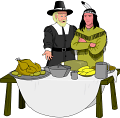 first
Thanksgiving feast.They
invited 91 Indians who had helped them survive their first
year.
It is believed that the Pilgrims would not have made it through the
year
without the help of the natives (Indians). The feast was more of
a traditional English harvest festival than a true "thanksgiving"
observance.
It lasted three days.
first
Thanksgiving feast.They
invited 91 Indians who had helped them survive their first
year.
It is believed that the Pilgrims would not have made it through the
year
without the help of the natives (Indians). The feast was more of
a traditional English harvest festival than a true "thanksgiving"
observance.
It lasted three days.
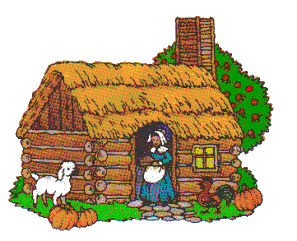 Governor
William Bradford sent "four men fowling" (hunting) after wild ducks and
geese. We're not sure if wild turkey was part of their
feast.
However, it is certain that they had venison. The term "turkey" was
used
by the Pilgrims to mean any sort of wild fowl. Governor
William Bradford sent "four men fowling" (hunting) after wild ducks and
geese. We're not sure if wild turkey was part of their
feast.
However, it is certain that they had venison. The term "turkey" was
used
by the Pilgrims to mean any sort of wild fowl.
They probably didn't have pumpkin
pie that
year.
The supply of flour had
been long diminished, so there was no bread or
pies of any kind. They did eat boiled pumpkin, and they
made
a type of fried bread from
corn. There was also no milk, cider, potatoes, or
butter.
Because all the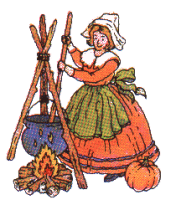 cows
were wild, there was no milk, cheese, or dairy
products. The
newly-discovered potato was still considered by many Europeans to
be poisonous, so they probably did not eat potatoes. But
the
feast did include fish, berries, watercress, lobster, dried
fruit,
clams, venison, and plums. cows
were wild, there was no milk, cheese, or dairy
products. The
newly-discovered potato was still considered by many Europeans to
be poisonous, so they probably did not eat potatoes. But
the
feast did include fish, berries, watercress, lobster, dried
fruit,
clams, venison, and plums.
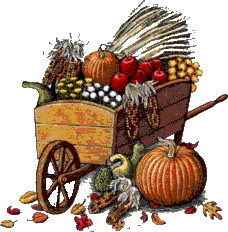 On
June 20, 1676, the governing council of Charlestown,
Massachusetts,
held a meeting to determine how best to express thanks for the good
crops
they had received. By unanimous vote they instructed Edward
Rawson,
the clerk, to proclaim June 29 as a day of
thanksgiving. On
June 20, 1676, the governing council of Charlestown,
Massachusetts,
held a meeting to determine how best to express thanks for the good
crops
they had received. By unanimous vote they instructed Edward
Rawson,
the clerk, to proclaim June 29 as a day of
thanksgiving.
George
Washington
proclaimed
a National Day of Thanksgiving in 1789, although some were
opposed
to it. President Thomas Jefferson didn't
like
the idea of having a day of thanksgiving.
It was Sarah
Josepha
Hale,
a magazine editor, worked hard to get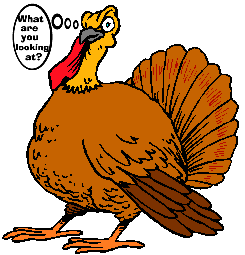 Thanksgiving
made a national holiday. Finally,
after a 40-year campaign of writing editorials and letters to governors
and presidents, Hale's obsession became a reality when, in 1863,
President Lincoln proclaimed the last Thursday in November as a
national
day of Thanksgiving.
Thanksgiving
made a national holiday. Finally,
after a 40-year campaign of writing editorials and letters to governors
and presidents, Hale's obsession became a reality when, in 1863,
President Lincoln proclaimed the last Thursday in November as a
national
day of Thanksgiving.
 Thanksgiving
was proclaimed by every
president after
Lincoln. The date was changed a couple of times,
most recently by Franklin D. Roosevelt, who set it up one week
earlier
in order to create a longer Christmas shopping season.
The people got upset and so the president moved Thanksgiving back
to its original date two years later. And
in 1941, Thanksgiving was finally sanctioned by Congress as a
legal
holiday, as the fourth Thursday in November. Thanksgiving
was proclaimed by every
president after
Lincoln. The date was changed a couple of times,
most recently by Franklin D. Roosevelt, who set it up one week
earlier
in order to create a longer Christmas shopping season.
The people got upset and so the president moved Thanksgiving back
to its original date two years later. And
in 1941, Thanksgiving was finally sanctioned by Congress as a
legal
holiday, as the fourth Thursday in November.
On January 31, 1957, Canada's
Parliament
declared
the second Monday in October of
each
year to be "A Day of General Thanksgiving to God for the bountiful
harvest
with which Canada has been blessed".
CORNUCOPIA,
(korn-yoo-KO-pee-uh)
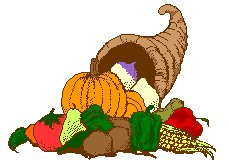 One
of the most recognizable symbols of Thanksgiving is the cornucopia,
also called horn of plenty. It is a decorative
motif, originating
in ancient Greece, that symbolizes abundance. The original
cornucopia
was a curved goat's horn filled to overflowing with fruit and
grain.
It symbolizes the horn possessed by Zeus's nurse, the Greek nymph
Amalthaea, which could be filled with whatever the owner wished. One
of the most recognizable symbols of Thanksgiving is the cornucopia,
also called horn of plenty. It is a decorative
motif, originating
in ancient Greece, that symbolizes abundance. The original
cornucopia
was a curved goat's horn filled to overflowing with fruit and
grain.
It symbolizes the horn possessed by Zeus's nurse, the Greek nymph
Amalthaea, which could be filled with whatever the owner wished. |

Click here to go back to main page
|
 The Pilgrims
landed at Plymouth Rock on December 11, 1620. There were 102
people
who was on the Mayflower. Their first winter was hard and 46
people
died. In the year 1621, they had lots of food
grow
that year and the colonists (pilgrims) decided to celebrate with the
The Pilgrims
landed at Plymouth Rock on December 11, 1620. There were 102
people
who was on the Mayflower. Their first winter was hard and 46
people
died. In the year 1621, they had lots of food
grow
that year and the colonists (pilgrims) decided to celebrate with the first
Thanksgiving feast.They
invited 91 Indians who had helped them survive their first
year.
It is believed that the Pilgrims would not have made it through the
year
without the help of the natives (Indians). The feast was more of
a traditional English harvest festival than a true "thanksgiving"
observance.
It lasted three days.
first
Thanksgiving feast.They
invited 91 Indians who had helped them survive their first
year.
It is believed that the Pilgrims would not have made it through the
year
without the help of the natives (Indians). The feast was more of
a traditional English harvest festival than a true "thanksgiving"
observance.
It lasted three days.  Governor
William Bradford sent "four men fowling" (hunting) after wild ducks and
geese. We're not sure if wild turkey was part of their
feast.
However, it is certain that they had venison. The term "turkey" was
used
by the Pilgrims to mean any sort of wild fowl.
Governor
William Bradford sent "four men fowling" (hunting) after wild ducks and
geese. We're not sure if wild turkey was part of their
feast.
However, it is certain that they had venison. The term "turkey" was
used
by the Pilgrims to mean any sort of wild fowl.  cows
were wild, there was no milk, cheese, or dairy
products. The
newly-discovered potato was still considered by many Europeans to
be poisonous, so they probably did not eat potatoes. But
the
feast did include fish, berries, watercress, lobster, dried
fruit,
clams, venison, and plums.
cows
were wild, there was no milk, cheese, or dairy
products. The
newly-discovered potato was still considered by many Europeans to
be poisonous, so they probably did not eat potatoes. But
the
feast did include fish, berries, watercress, lobster, dried
fruit,
clams, venison, and plums.  On
June 20, 1676, the governing council of Charlestown,
Massachusetts,
held a meeting to determine how best to express thanks for the good
crops
they had received. By unanimous vote they instructed Edward
Rawson,
the clerk, to proclaim June 29 as a day of
thanksgiving.
On
June 20, 1676, the governing council of Charlestown,
Massachusetts,
held a meeting to determine how best to express thanks for the good
crops
they had received. By unanimous vote they instructed Edward
Rawson,
the clerk, to proclaim June 29 as a day of
thanksgiving.  Thanksgiving
made a national holiday. Finally,
after a 40-year campaign of writing editorials and letters to governors
and presidents, Hale's obsession became a reality when, in 1863,
President Lincoln proclaimed the last Thursday in November as a
national
day of Thanksgiving.
Thanksgiving
made a national holiday. Finally,
after a 40-year campaign of writing editorials and letters to governors
and presidents, Hale's obsession became a reality when, in 1863,
President Lincoln proclaimed the last Thursday in November as a
national
day of Thanksgiving.  Thanksgiving
was proclaimed by every
president after
Lincoln. The date was changed a couple of times,
most recently by Franklin D. Roosevelt, who set it up one week
earlier
in order to create a longer Christmas shopping season.
The people got upset and so the president moved Thanksgiving back
to its original date two years later. And
in 1941, Thanksgiving was finally sanctioned by Congress as a
legal
holiday, as the fourth Thursday in November.
Thanksgiving
was proclaimed by every
president after
Lincoln. The date was changed a couple of times,
most recently by Franklin D. Roosevelt, who set it up one week
earlier
in order to create a longer Christmas shopping season.
The people got upset and so the president moved Thanksgiving back
to its original date two years later. And
in 1941, Thanksgiving was finally sanctioned by Congress as a
legal
holiday, as the fourth Thursday in November.
 One
of the most recognizable symbols of Thanksgiving is the cornucopia,
also called horn of plenty. It is a decorative
motif, originating
in ancient Greece, that symbolizes abundance. The original
cornucopia
was a curved goat's horn filled to overflowing with fruit and
grain.
It symbolizes the horn possessed by Zeus's nurse, the Greek nymph
Amalthaea, which could be filled with whatever the owner wished.
One
of the most recognizable symbols of Thanksgiving is the cornucopia,
also called horn of plenty. It is a decorative
motif, originating
in ancient Greece, that symbolizes abundance. The original
cornucopia
was a curved goat's horn filled to overflowing with fruit and
grain.
It symbolizes the horn possessed by Zeus's nurse, the Greek nymph
Amalthaea, which could be filled with whatever the owner wished. 